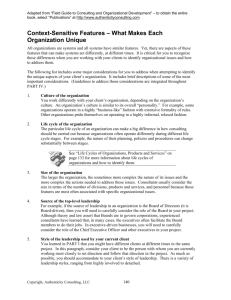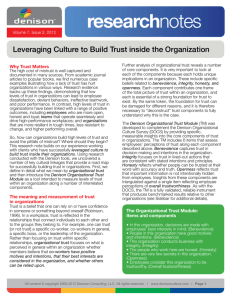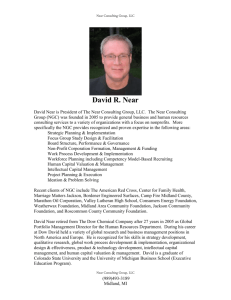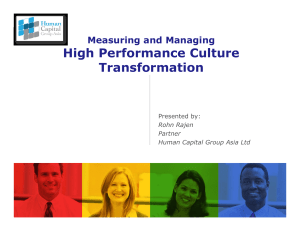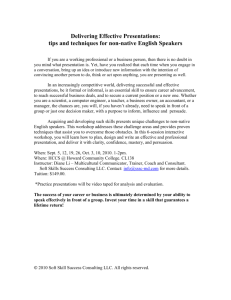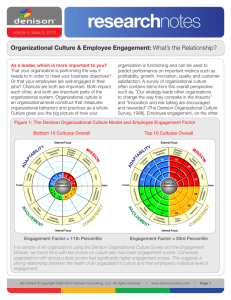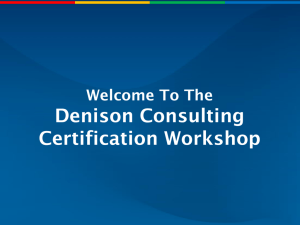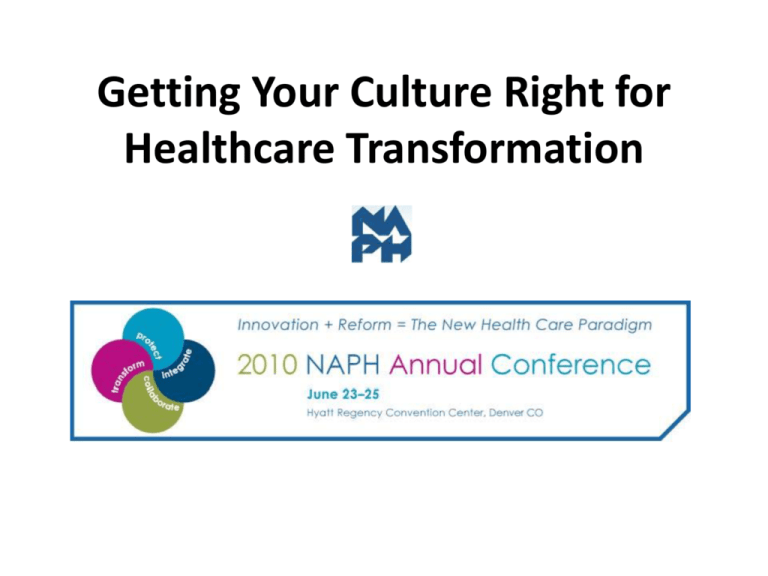
Getting Your Culture Right for
Healthcare Transformation
Panel Members
• Reginald W. Coopwood, MD, FACS
– President and Chief Executive Officer
Regional Medical Center, Memphis TN
• Lisa E. Harris, MD
– Chief Executive Officer and Medical Director
Wishard Health Services, Indianapolis IN
• Anna Roth, RN
– Chief Executive Officer
Contra Costa Regional Medical Center, Martinez CA
2
Breakout Session Objectives
• Learn a simple framework for understanding culture and the
importance of getting it right for organizational
transformation
• Compare your organization’s culture to a healthcare industry
benchmark
• Learn about ways that leaders can change culture to support
organizational transformation
3
Corporate Values
•
•
•
•
Communication
Respect
Integrity
Excellence
Do these look familiar?
They were Enron’s (espoused) Corporate Values!
4
Culture is Often Hidden
Norms, Behaviors &
Artifacts
Visible & Tangible
Personal Values &
Attitudes
Less Visible but
Talked About
Cultural Values &
Assumptions
Not Visible and
Rarely Questioned
5
What is Culture?
Culture is the shared set of beliefs, values, and behaviors that
have contributed to the organization’s success in the
marketplace over time. It is a powerful yet invisible force that
fosters cohesion, reinforces organizational identity, and
pervades every aspect of how the business is run.
“It is the way we do things around here.”
6
Some Examples of Culture (Positive)
• The vision of the organization is widely shared and it provides
meaning and direction to the work of staff.
• There is clear agreement on the right way and wrong way to
do things.
• Different parts of the organization often cooperate to create
change.
• Authority is delegated so that people can act on their own.
7
Why is Culture Important
“Any competitor can duplicate our putting satellite TV’s in every
seat, any competitor can duplicate our larger overhead bin space,
any competitor can duplicate our extra leg room, any competitor
can duplicate our roomier leather seats, but NO competitor can
duplicate the culture and leadership we’ve created that delivers
the JetBlue experience to our customers.”
David Neeleman, CEO, JetBlue Airways
8
Changing Perceptions of Business Culture
From…
To…
Intangible, esoteric, and
difficult to manage.
Behaviorally based, measurable, and
manageable via deliberate leadership.
Just happens.
Result of thoughtful leadership, values
orientation, and involvement of the
entire organization in a focused direction.
Luxury when there is time
Have strategic impact that must be
managed to preserve business value and
ensure success.
9
Why Address Culture Now?
The Opportunity:
Never Waste a Crisis - Great leaders know
that significant opportunity lies
in a world turned upside down.
Dr. Saj-nicole Joni
chief executive of Cambridge International Group
The Approach:
Culture will have a significant impact on the
organization’s ability to effectively transform itself
10
A Framework for Understanding Culture
Translating the
demands of the
business environment
into action
Building human capability,
ownership, and responsibility
Defining a meaningful
long-term direction
for the Company
Defining the values
and systems that are the
basis of a strong culture
11
© Denison Consulting, LLC. All Rights Reserved
Does Culture Matter? – Links to Performance
Growth
Market Share
Stable
Performance
Over Time
Profitability
ROI, ROE
Innovation &
Customer
Satisfaction
Operating Performance
Quality
Employee Satisfaction
© Denison Consulting, LLC. All Rights Reserved
12
Composite for US Healthcare Organizations
Percentile is the
composite score as a
percentage
benchmarked against
the average of other
organizations.
13
© Denison Consulting, LLC. All Rights Reserved
Dynamic Tension
Dynamic Tension:
Linking the purpose,
direction, and goals of the
organization
(top - down) to a shared
sense of responsibility,
ownership and
commitment with all
employees (bottom - up).
14
© Denison Consulting, LLC. All Rights Reserved
Dynamic Tension
Dynamic Tension:
Successful organizations
learn how to cope with
the dual problems of
external adaptation
(stimulate progress) and
internal integration
(preserve the core).
15
© Denison Consulting, LLC. All Rights Reserved
Changing the Culture Example – HealthPlus of Michigan*
• Core Business – provider of HMO and point-of-service health plans
• Employees – 400
• Opportunity – Stability in the industry in 1997 provided chance to focus
on internal infrastructure and monitor/measure an environment that
could be continuously improved
• Results:
– Below the 25 percentile for most all of the culture traits
– Chose to focus on Mission first – strengthening the vision, developed a
strategy, communicated it to staff, and set individual performance goals for
staff tied to the company plan
– Suffered a setback in 2001 from the pressures of intense competition
– Continued the process with focus on specific areas such as Core Values and
Capability Development
– By 2007, company was scoring higher than 85% of all benchmarked companies
* Published by Denison Consulting, Volume 3, Issue 2, 2009
16
Changing the Culture Example –
University of Maryland Medical Center*
• Core Business – Healthcare facility, 700 beds, 1,000 attending physicians,
300,000 patients per year
• Employees – 6,600
• Opportunity – Poor financial and operating performance in late 1990’s led
senior leadership team to believe that culture change was needed
• Results:
– Initially received low results on culture and leadership surveys
– Goal – help leaders develop the skills and relationships needed to make
culture stronger and healthier
– Implemented a comprehensive leadership development program
– Organization needed to learn a new level of empowerment – authentic and
truthful conversations with viewpoints respected by senior leaders
– Culture survey scores increased on 11 of 12 traits and net income increased
150%
* Published in the Organization Development Journal; Winter 2007, page 63
17
Creating a Master Plan for Change
• Gain a full understanding of the current reality – what aspects of culture
need to be strengthened to improve the success of the organization
• Determine the best place to start, typically Mission and Involvement
– Mission – shared vision for the organization of the future, with ambitious but
realistic goals, that motivates staff and gives meaning and direction to their work
– Involvement – Accomplishing the shared goals and objectives in the organization
through information sharing, cooperation, and empowerment
• Design the right programs and interventions to improve the culture
• Broaden the ownership of the transformation to all internal and external
stakeholders
• Execute the plan and monitor results
18
Your Assignment – Analyze Your Organization
19
© Denison Consulting, LLC. All Rights Reserved
How did you go bankrupt?
Two ways. Gradually, then suddenly.
Ernest Hemingway
The Sun Also Rises
20
Getting Your Culture Right for
Healthcare Transformation


